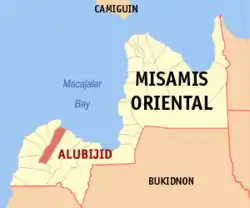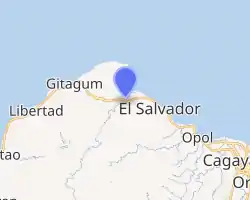Alubijid
Alubijid, officially the Municipality of Alubijid (Cebuano: Lungsod sa Alubijid; Tagalog: Bayan ng Alubijid), is a 4th class municipality in the province of Misamis Oriental, Philippines. According to the 2015 census, it has a population of 29,724 people. [3]
Alubijid | |
|---|---|
| Municipality of Alubijid | |
 Seal | |
 Map of Misamis Oriental with Alubijid highlighted | |
OpenStreetMap 
| |
.svg.png.webp) Alubijid Location within the Philippines | |
| Coordinates: 8°34′17″N 124°28′30″E | |
| Country | |
| Region | Northern Mindanao (Region X) |
| Province | Misamis Oriental |
| District | 2nd District |
| Barangays | 16 (see Barangays) |
| Government | |
| • Type | Sangguniang Bayan |
| • Mayor | Emmanuel L. Jamis |
| • Vice Mayor | Alvin Giovanni A. Labis |
| • Representative | Juliette T. Uy |
| • Electorate | 20,636 voters (2019) |
| Area | |
| • Total | 85.56 km2 (33.03 sq mi) |
| Elevation | 51 m (167 ft) |
| Population | |
| • Total | 29,724 |
| • Density | 350/km2 (900/sq mi) |
| • Households | 7,627 |
| Economy | |
| • Income class | 4th municipal income class |
| • Poverty incidence | 36.53% (2015)[4] |
| • Revenue | ₱101,070,574.41 (2016) |
| Time zone | UTC+8 (PST) |
| ZIP code | 9018 |
| PSGC | |
| IDD : area code | +63 (0)88 |
| Climate type | tropical climate |
| Native languages | Cebuano Binukid Subanon Tagalog |
| Website | www |
Etymology and history
The municipality name, "Alubijid", pronounced alubihid due to Spanish accent, is the local term for the hog plum tree.
Alubijid, along with El Salvador, was part of Cagayan de Misamis (present-day Cagayan de Oro) when the two entities petitioned to become municipalities in 1933. Alubijid became a separate town in 1940, and El Salvador became one 9 years later.
Barangays
Alubijid is politically subdivided into 16 barangays.
- Baybay
- Benigwayan
- Calatcat
- Lagtang
- Lanao
- Loguilo
- Lourdes
- Lumbo
- Molocboloc
- Poblacion
- Sampatulog
- Sungay
- Talaba
- Taparak
- Tugasnon
- Tula
Climate
| Climate data for Alubijid, Misamis Oriental | |||||||||||||
|---|---|---|---|---|---|---|---|---|---|---|---|---|---|
| Month | Jan | Feb | Mar | Apr | May | Jun | Jul | Aug | Sep | Oct | Nov | Dec | Year |
| Average high °C (°F) | 28 (82) |
29 (84) |
30 (86) |
31 (88) |
30 (86) |
30 (86) |
30 (86) |
30 (86) |
30 (86) |
30 (86) |
29 (84) |
29 (84) |
30 (85) |
| Average low °C (°F) | 24 (75) |
24 (75) |
24 (75) |
25 (77) |
26 (79) |
26 (79) |
25 (77) |
25 (77) |
25 (77) |
25 (77) |
25 (77) |
25 (77) |
25 (77) |
| Average precipitation mm (inches) | 271 (10.7) |
217 (8.5) |
193 (7.6) |
178 (7.0) |
344 (13.5) |
423 (16.7) |
362 (14.3) |
358 (14.1) |
329 (13.0) |
320 (12.6) |
322 (12.7) |
260 (10.2) |
3,577 (140.9) |
| Average rainy days | 23.2 | 19.5 | 22.0 | 22.8 | 29.6 | 28.9 | 30.3 | 29.8 | 28.1 | 28.8 | 26.1 | 24.1 | 313.2 |
| Source: Meteoblue [5] | |||||||||||||
Demographics
|
| ||||||||||||||||||||||||||||||||||||||||||
| Source: Philippine Statistics Authority [3] [6] [7][8] | |||||||||||||||||||||||||||||||||||||||||||
In the 2015 census, the population of Alubijid was 29,724 people, [3] with a density of 350 inhabitants per square kilometre or 910 inhabitants per square mile.
Schools
College:
- University of Science and Technology of Southern Philippines (Main Campus)
- Bukidnon State University - Alubijid Extension
High schools:
- Alubijid National Comprehensive High School
- Lourdes National High School
- Living Hope Christian Academy (Private)
Elementary schools:
- Alubijid Central School
- Baybay Elementary School
- Benigwayan Elementary School
- Calatcat Elementary School
- Lagtang Elementary School
- Lanao Elementary School
- Loguilo Elementary School
- Lourdes Elementary School
- Lumbo Elementary School
- Molocboloc Elementary School
- Sampatulog Elementary School
- Sungay Elementary
- Talaba Elementary School
- Taparak Elementary School
- Tugasnon Elementary School
- Tula Elementary School
References
- Municipality of Alubijid | (DILG)
- "Province: Misamis Oriental". PSGC Interactive. Quezon City, Philippines: Philippine Statistics Authority. Retrieved 12 November 2016.
- Census of Population (2015). "Region X (Northern Mindanao)". Total Population by Province, City, Municipality and Barangay. PSA. Retrieved 20 June 2016.
- "PSA releases the 2015 Municipal and City Level Poverty Estimates". Quezon City, Philippines. Retrieved 12 October 2019.
- "Alubijid: Average Temperatures and Rainfall". Meteoblue. Retrieved 29 April 2020.
- Census of Population and Housing (2010). "Region X (Northern Mindanao)". Total Population by Province, City, Municipality and Barangay. NSO. Retrieved 29 June 2016.
- Censuses of Population (1903–2007). "Region X (Northern Mindanao)". Table 1. Population Enumerated in Various Censuses by Province/Highly Urbanized City: 1903 to 2007. NSO.
- "Province of Misamis Oriental". Municipality Population Data. Local Water Utilities Administration Research Division. Retrieved 17 December 2016.
External links
- Alubijid Profile at PhilAtlas.com
- Philippine Standard Geographic Code
- Philippine Census Information
- Local Governance Performance Management System
- Official website